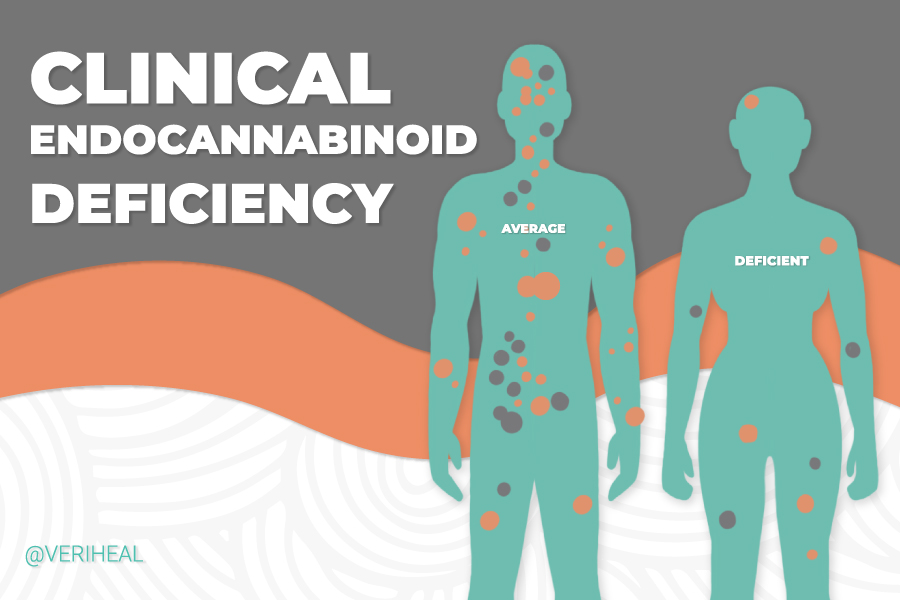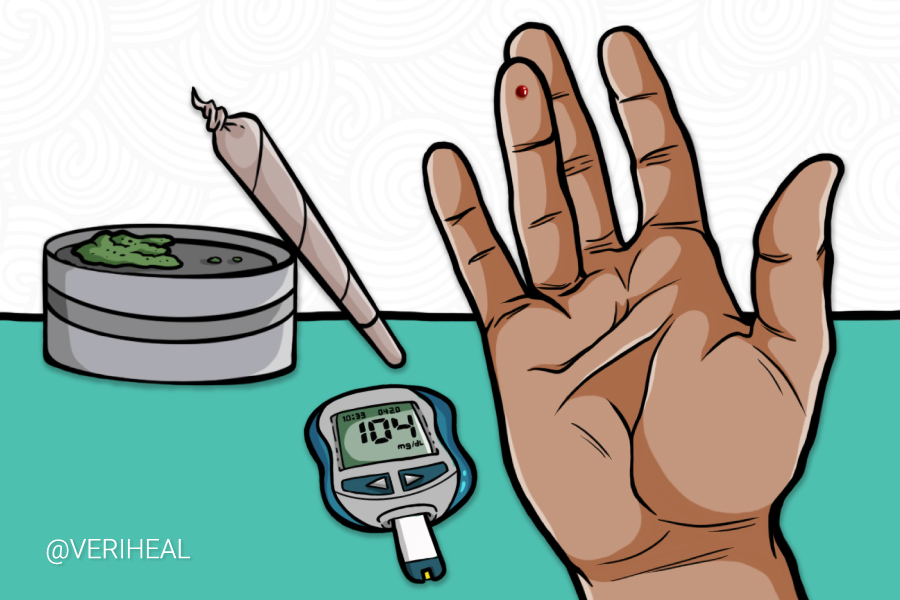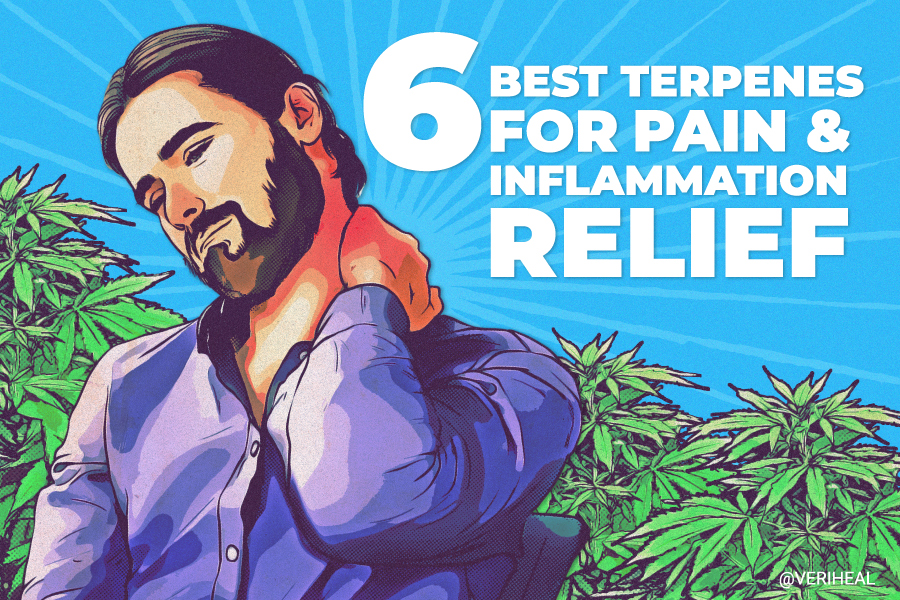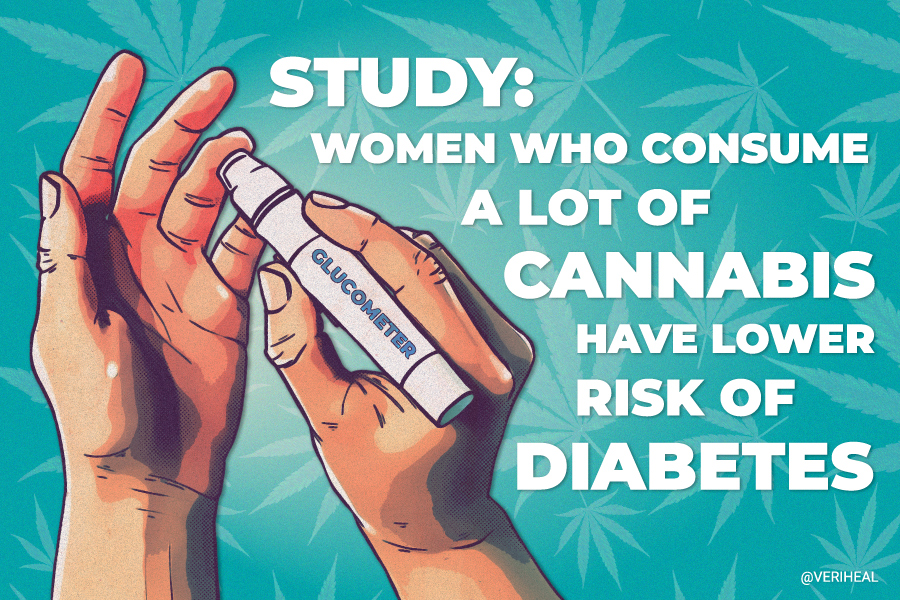Cannabis Treatment for Bell’s Palsy

- Bell’s Palsy Signs, Symptoms and Types
- Bell’s Palsy Treatment: Can Cannabinoids Provide Relief?
- What Preparations of Cannabis are Best for Bell’s Palsy?
- Talking to Your Doctor About These Types of Treatments
Anyone of any age and from any walk of life can be struck with Bell’s palsy – an acute peripheral facial weakness of unknown cause. This medical condition is characterized by muscle weakness or paralysis that causes one half of the face to suddenly sink downwards and worsen over a 48-hour period.
Bell’s Palsy—which is otherwise known as Antoni’s Palsy, facial nerve palsy, facial paralysis, idiopathic facial palsy, or refrigeration palsy—is believed to affect all genders equally. According to the National Association for Rare Disorders (NARD), an estimated 25-35 per 100,000 people in the United States are affected with the condition (5).
Less common among people below the age of 15 and over the age of 60, Bell’s palsy is not considered to be a permanent condition, with most mild cases resolving within two weeks to six months from the onset. However, 20% of people will endure long-term facial paralysis and drooping. The good news is that the majority of people with Bell’s palsy recover complete facial strength and expression (1).
Since this lack of movement on one side of the face is usually accompanied by a dull aching, Bell’s palsy patients may benefit from using cannabis as a pain management tool. Before we explore the efficacy of cannabis-based medicines, let’s take a moment to learn more about this temporary facial weakness.
Bell’s palsy Signs, Symptoms and Types
While Bell’s Palsy doesn’t have a biological gender bias, some people are still more prone to developing it than others. These include pregnant people, people aged 15-60, and those who have:
- Autoimmune disease
- Diabetes
- Family history of Bell’s palsy
- Cold sores (herpes simplex virus)
- High blood pressure (hypertension)
- Mononucleosis (Epstein-Barr virus)
- Shingles (herpes zoster virus) (1)
When someone suffers from Bell’s palsy, the function of the facial nerve will be disturbed, thus interrupting essential brain signaling to the facial muscles. As a direct effect of this, abrupt facial weakness or paralysis occurs.
Some of the most common symptoms of Bell’s palsy include the following:
- Drooling
- Difficulty/inability to close one eye on the affected side of the face
- Muddled movement of facial expression-controlling muscles that affect blinking, squinting, and smiling
- Headache
- Loss of sensitivity in the face
- Sensory deprivation on the front two-thirds of the tongue
- Sound hypersensitivity in the affected ear (hyperacusis)
Due to the fact that the symptoms of Bell’s palsy may be similar to other serious conditions or medical problems like stroke—it’s important that you promptly visit a local emergency room and contact a professional healthcare provider for a proper diagnosis. Treating Bell’s palsy as early as possible can not only help rule out other serious conditions, but can help improve outcomes and shorten its duration.
The severity of Bell’s palsy symptoms vary from mild weakness to total facial paralysis. In cases where the facial nerve is more tightly compressed and inflamed, the nerve will usually take longer to heal and regain normal functioning.
Bell’s palsy Causes and Complications
Although the primary cause is unknown, Bell’s palsy transpires when the facial nerves become damaged or traumatized in some way. Also known as the 7th cranial nerve, this facial nerve exists inside the facial canal. The nerve travels from the brainstem, through skull openings, then to the face.
The 7th cranial nerve’s role is to transfer messages between the brain and facial muscles responsible for eye blinking and closing, smiling, and frowning. The nerve also sends impulses to the lacrimal or tear glands and the saliva glands, as well as sends taste sensations from the tongue. Additionally, it transmits impulses to a bone inside the middle of the ear called the stapes or stirrup.
Facial paralysis may be a sign of a more serious condition, such as:
- Diabetes
- Guillain-Barré syndrome
- High blood pressure
- Injury
- Infection
- Lyme disease
- Myasthenia gravis
- Multiple sclerosis
- Sarcoidosis
- Stroke
- Toxins
- Tumor
To rule out an underlying condition, it’s advisable to see a doctor or healthcare provider as soon as possible who can evaluate your case – preferably in an emergency-ready setting.
Bell’s palsy Treatment: Can Cannabinoids Provide Relief?
Getting treatment for Bell’s palsy begins with an ER, urgent care, or doctor’s appointment. After assessing your symptoms and emergency imaging, a diagnosis can be made. Although there are no specific tests designed to detect Bell’s palsy, healthcare providers will check labs for other causes such as Lyme disease or electrolyte abnormalities. After all other emergency imaging and labs are clear, then they usually will be able to make a diagnosis after performing a facial and neurological examination (e.g., asking you to carry out typical facial and muscle movements).
Initial and long-term tests may include:
- Blood tests to figure out if a different condition might be present, such as diabetes or Lyme disease
- Electromyography (EMG) to determine the seriousness of the nerve involvement/damage
- Computed tomography (CT) or magnetic resonance imaging (MRI) to pinpoint an underlying cause for your symptoms and rule out serious causes
Within six months, Bell’s palsy patients will usually have fully recovered. To prevent the risk of the facial muscles becoming permanently contracted some patients may seek out physiotherapy. Depending on the severity of your symptoms and your particular health history, a doctor or healthcare provider may prescribe alternative treatments for your specific condition.
One of the most recommended treatments to prevent ophthalmic complications in patients with Bell’s palsy involves the use of topical ocular lubrication. An eye patch may also help to shield the cornea from being scratched, which is imperative to the management of this medical condition.
Analgesics, antiviral medicine, and steroids that reduce inflammation may be prescribed to help treat the symptoms of Bell’s palsy. Some doctors might also recommend physical therapy as a way of stimulating the facial nerve.
Most people with Bell’s palsy will not need treatment, since the symptoms usually clear up on their own. Fortunately, it is “non-progressive,” meaning that it should not get worse over time.
Sometimes, steroids are initially prescribed for the first 48 hours in order to relieve any inflammation that could be causing or contributing to Bell’s palsy. Based on your health history, you may also be prescribed antiviral medication and pain relieving medication along with warm compresses to the face. Nonetheless, cannabis could also be beneficial to the condition, since it has shown promise when used for relief from the neuropathic side effects of Bell’s palsy.
Currently, research into the use of medical marijuana in Bell’s palsy and neuropathy in general is somewhat limited, and Bell’s palsy is not directly studied yet with respect to cannabis. This is not to say that cannabis cannot provide some respite from some of the symptoms, however.
Neuroprotective Effects of Cannabis
Cannabis harbors neuroprotective powers that may help to minimize free radicals that impact nerve cell damage. One particular study published in Frontiers in Pharmacology found that THC and CBD could be suitable pharmacological tools for treating neurodegenerative disorders (2). New and early research looking at minor cannabinoids like CBG and CBDA may also be promising for neuropathy and neuroprotective effects.
Anti-inflammatory Properties of Cannabis
Since the facial nerve in Bell’s palsy patients tends to become inflamed and swollen, the powerful anti-inflammatory effects of cannabinoids could come in handy. One review showed that CBD, CBG, and CBD+THC combinations exert “a predominantly anti-inflammatory effect in vivo (3).”
Cannabis and Pain Relief
Jaw pain and discomfort in the face and head are common symptoms of Bell’s palsy. Fortunately, as a natural pain reliever, cannabis could hold the key to unlocking improved comfort for patients who have been diagnosed with the medical condition. The psychoactive compound delta-9 tetrahydrocannabinol (THC) in low doses has been shown to work as a potent analgesic. Combinations and single uses of THC and cannabidiol (CBD), as well as minor cannabinoids like CBN and CBG also have data to support their use in neuropathic pain and inflammation (4, 9, 7). Cannabinoids are capable of blocking certain neurotransmitters, such as pain-producing and pain-sensitizing pathways (6).
What Preparations of Cannabis are Best for Bell’s palsy?
The type of cannabis preparation you choose depends on how quickly you want to experience the plant’s remedial effects, as well as how long you want the effects to last and your personal preferences in terms of cannabis consumption.
Let’s take a look at some recommended preparations of cannabis for Bell’s palsy:
- Smokable and Vaporizable Flower – For fast relief, opt for smokable, or better yet dry-herb vaporized, flower. Using flower, you can inhale the cannabis plant’s primary active cannabinoids and experience the effects within mere minutes. If going the inhaled route, dry herb vaporizing is best to minimize tar and free radical consumption, protecting cardiopulmonary health, while improving cannabinoid inhalation.
- Vaporizable Oils – As a method of cannabis consumption that also involves inhaling the plant’s active compounds, you can expect the effects of vaporizable oils to kick in quickly and last for 1-3 hours. To ensure optimal medical use, check to see if the oils have terpenes in them or have been re-added as they are often lost to distillation but are almost equally medically important.
- Sublingual Tinctures – When consumed sublingually, such as by dropping a CBD oil tincture onto or beneath the tongue, cannabis’ active chemicals largely bypass the digestive system by interacting with the body’s oral mucosa—absorbent membranes lining the inside of the mouth—before making their way into the bloodstream. A portion of ingested tincture will be absorbed rapidly, and the other will be digested and felt for longer than inhaling.
- Ingestible Edibles – Discreet dosing, convenience, and diversity are three perks associated with consuming cannabis-infused food. Otherwise known as an edible, a cannabis food product contains decarboxylated cannabinoids from the plant. The effects may not surface for 30 minutes to two hours, but the symptomatic relief can last for up to eight hours.
Talking to Your Doctor About These Types of Treatments
Ear, nose and throat physicians (ENTs) specialize in the diagnosis, rehabilitation, and treatment of disorders that affect the head, ears, neck, and nose, such as Bell’s palsy. These specialist doctors are better known as otolaryngologists.
If you know you are suffering from Bell’s palsy, organizing a consultation with a professional in the field of otolaryngology should be your next priority after being cleared by the ER. During a doctor’s visit, you ought to provide any relevant information pertaining to your symptoms, as well as inform the healthcare professional of any medications you are currently using.
Explain to your physician the main reason(s) why you feel that you would benefit from medical cannabis and don’t forget to discuss your family’s medical history, since this could influence your risk of developing hereditary conditions like Bell’s palsy (8).
Complementary Treatments Worth Discussing with Your Doctor
Bell’s palsy normally begins to improve within as little as two weeks, but it’s possible that the condition will linger for 3-6 months before a patient regains full control of their facial muscles. It is advisable to tell your healthcare provider if you don’t notice any improvement in your symptoms. Remember that new facial drooping and abnormal weakness should be evaluated in your local ER right away.
Bell’s palsy patients who want to make their recovery process more bearable may opt for alternative therapies, such as acupuncture, biofeedback training, electrical stimulation, relaxation, craniosacral therapy, and vitamin B12, B6, or zinc vitamin therapy.
Should you be considering using cannabis as an alternative method of treatment for Bell’s palsy, get in touch with the Veriheal team.
Note: The content on this page is for informational purposes only and is not intended to be professional medical advice. Do not attempt to self-diagnose or prescribe treatment based on the information provided. Always consult a physician before making any decision on the treatment of a medical condition.
1. Bell’s Palsy: Symptoms, diagnosis & treatment. Cleveland Clinic. (n.d.). Retrieved August 22, 2022, from https://my.clevelandclinic.org/health/diseases/5457-bells-palsy
2. Cassano, T., Villani, R., Pace, L., Carbone, A., Bukke, V. N., Orkisz, S., Avolio, C., & Serviddio, G. (2020). From cannabis sativa to cannabidiol: Promising therapeutic candidate for the treatment of Neurodegenerative Diseases. Frontiers in Pharmacology, 11. https://www.ncbi.nlm.nih.gov/pmc/articles/PMC7069528/
3. Henshaw, F. R., Dewsbury, L. S., Lim, C. K., & Steiner, G. Z. (2021). The effects of cannabinoids on pro- and anti-inflammatory cytokines: A systematic review of in vivo studies. Cannabis and Cannabinoid Research, 6(3), 177–195. https://pubmed.ncbi.nlm.nih.gov/33998900/
4. Hoggart, B., Ratcliffe, S., Ehler, E., Simpson, K. H., Hovorka, J., Lejčko, J., Taylor, L., Lauder, H., & Serpell, M. (2014). A multicentre, open-label, follow-on study to assess the long-term maintenance of effect, tolerance and safety of THC/CBD OROMUCOSAL spray in the management of neuropathic pain. Journal of Neurology, 262(1), 27–40. https://pubmed.ncbi.nlm.nih.gov/25270679/
5. Sencen, L. (2022, June 22). Bell’s Palsy. NORD (National Organization for Rare Disorders). Retrieved August 22, 2022, from https://rarediseases.org/rare-diseases/bells-palsy/
6. Vučković, S., Srebro, D., Vujović, K. S., Vučetić, Č., & Prostran, M. (2018). Cannabinoids and pain: New insights from old molecules. Frontiers in Pharmacology, 9. https://www.ncbi.nlm.nih.gov/pmc/articles/PMC6277878/
7. Walsh, K. B., McKinney, A. E., & Holmes, A. E. (2021). Minor cannabinoids: Biosynthesis, molecular pharmacology and potential therapeutic uses. Frontiers in Pharmacology, 12. https://www.frontiersin.org/articles/10.3389/fphar.2021.777804/full
8. Willbrand, J. W., Blumhagen, J. D., & May, M. (1974). Inherited Bell’s Palsy. Annals of Otology, Rhinology & Laryngology, 83(3), 343–346. https://journals.sagepub.com/doi/abs/10.1177/000348947408300309?journalCode=aora
9. Wong, H., & Cairns, B. E. (2019). Cannabidiol, Cannabinol and their combinations act as peripheral analgesics in a rat model of myofascial pain. Archives of Oral Biology, 104, 33–39. https://www.sciencedirect.com/science/article/abs/pii/S0003996919302249?via%3Dihub

















